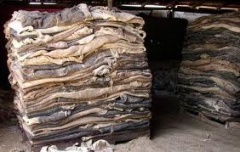Difference between revisions of "Hides and skins"
| Line 9: | Line 9: | ||
==Description== | ==Description== | ||
A hide is an animal skin treated for human use. Hides include [[leather]] from cattle and other livestock [[animals]], alligator skins, [[snake skins]] for shoes and fashion accessories and furs from wild cats, mink and bears. In some areas, [[leather]] is produced on a domestic or small industrial scale, but most leather making is done on a large scale. Various tannins are used for this purpose. | A hide is an animal skin treated for human use. Hides include [[leather]] from cattle and other livestock [[animals]], alligator skins, [[snake skins]] for shoes and fashion accessories and furs from wild cats, mink and bears. In some areas, [[leather]] is produced on a domestic or small industrial scale, but most leather making is done on a large scale. Various tannins are used for this purpose. | ||
| − | Animal hides are stretched, dried and tanned. It is more cost-effective today to raise [[animals]] in captivity and then kill them. Large farms exist to raise mink and rabbit for fur while much fox, lynx, wolf and other animals are trapped for fur. | + | Animal hides are stretched, dried and tanned. It is more cost-effective today to raise [[animals]] in captivity and then kill them. Large farms exist to raise mink and rabbit for fur while much fox, lynx, wolf and other animals are trapped for fur.<br><br> |
| + | ==Applications== | ||
| + | Fur and hides find their main use today as clothing, particularly coats. They are valued for their warmth, and as a status symbol. Rabbit fur is a popular material to make hats, coats and glove linings. Ermine fur was historically popular in ceremonial clothes of European monarchs. The black-tipped tails were arranged around the edges of robes, producing the familiar pattern of black diamonds on a white field. Because of this use, "ermine" became a term in heraldry, to mean a white field strewn with small bell-shaped designs called ermine-spots. | ||
| + | Leather from processed hides has a variety of uses, including shoes, clothing, horse tack, horse harness, upholstery and even wall or other surface coverings. | ||
Revision as of 09:48, 26 July 2012
| Infobox on Hides and skins | |
|---|---|
| Example of Hides and skins |  |
| Facts | |
| Origin | All continents |
| Stowage factor (in m3/t) |
|
| Humidity / moisture | - |
| Ventilation | Adequate circulation of air |
| Risk factors | Heating, wetting, mechanical influence (contact with metal) decomposition due to bacterial action |
Hides and skins
Description
A hide is an animal skin treated for human use. Hides include leather from cattle and other livestock animals, alligator skins, snake skins for shoes and fashion accessories and furs from wild cats, mink and bears. In some areas, leather is produced on a domestic or small industrial scale, but most leather making is done on a large scale. Various tannins are used for this purpose.
Animal hides are stretched, dried and tanned. It is more cost-effective today to raise animals in captivity and then kill them. Large farms exist to raise mink and rabbit for fur while much fox, lynx, wolf and other animals are trapped for fur.
Applications
Fur and hides find their main use today as clothing, particularly coats. They are valued for their warmth, and as a status symbol. Rabbit fur is a popular material to make hats, coats and glove linings. Ermine fur was historically popular in ceremonial clothes of European monarchs. The black-tipped tails were arranged around the edges of robes, producing the familiar pattern of black diamonds on a white field. Because of this use, "ermine" became a term in heraldry, to mean a white field strewn with small bell-shaped designs called ermine-spots. Leather from processed hides has a variety of uses, including shoes, clothing, horse tack, horse harness, upholstery and even wall or other surface coverings.











